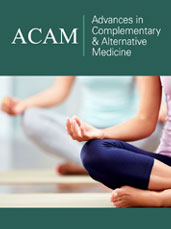- Submissions

Full Text
Advances in Complementary & Alternative medicine
Reminders for Clinical Application of Extra Acupoints
Tong Zheng Hong*
As-You-Wish Healthcare Institute, Taiwan
*Corresponding author: Tong Zheng Hong, As-You-Wish Healthcare Institute, Taiwan
Submission: June 13, 2018;Published: January 03, 2019

ISSN: 2637-7802 Volume3 Issue3
Abstract
Pattern identification is the key concept of the traditional Chinese Medicine theories, which unfortunately cannot apply to extra acupoints for the lack of Yin and Yang. However, the recent studies on extra acupoints selected in combination with traditional acupoints on the traditional fourteen meridians are marking the beginning of a new chapter.
Introduction
The Yin-Yang balance is the unique concept and one of the key principles of traditional Chinese medicine in the past two thousand years [1]. On the other hand, this concept serves as the foundation and the guide for the etiology of diseases, diagnosis, and treatments [2].
The balance of Yin and Yang can be achieved by stimulations such as acupuncture, acupressure, moxibustion, cupping, and Tui Naat acupoints. The classic protocol of Four Gates (LV3, Yin and LI4, Yang)demonstrating the application and importance of Yin and Yang is used for the successful treatment of the sub-health [3].
Brief relooking at development of acupuncture and extra acupoints
Extra acupoints and Ashi (Ah Shi, A yes) points, first discovered accidently to alleviate pain and certain sicknesses in the daily life in the ancient time, are not formally recognized and accepted to be incorporated into the traditional fourteen meridians but serve as the foundations of meridian theories during the Warring States Period (476-221 BC) [4].
Most of the extra acupoints are not associated with a specific meridian; however, some extra acupoints like Yintang (Yintang, M-HN-3), Sishencong (Sishen Cong, M-HN-1) are located on the Governing vessel, one of the Erbai (Two white,M-UE-29) is on the PC meridian, and Taiyang (sun, M-HN-9) is on the Sanjiao meridian [1].
Memo for therapeutic effects
Without the consideration of Yin and Yang, good results cannot be expected. An extra acupoint may be or may not on the meridians that are closely associated Yin and Yang. Each Five Shu- Point corresponds to one of specific phases of the Five Elements, highlighting the importance of balanced Yin and Yang. The Five Elements theory unfortunately cannot apply to extra points only because they are not on the traditional fourteen meridians.
Patterns are unique and pattern identification plays the most critical factor for the treatment and correlates closely with the successful outcomes. However, studies by Hong [1], Zhu et al. [5], Yu SY et al. [6] and Paraskeva, et al. [7] show extra acupoints are used together with traditional acupoints in clinic and research but patterns were not included in the research designs.
The historical developments of extra points show an extra point can surely play an essential role and be used alone for the treatment, even though they do not have the corresponding phases. Whether or not extra points can be selected in combination with traditional acupoints in a protocol for the more effective results of the treatments attracts attention.
Discussion
Tung’s acupuncture is the typical school of extra acupoints in the world. In the meantime, the new extra acupoint Gangshui (Liver water)discovered and used for sub-acute cough demonstrates numerous extra acupoints may remain undiscovered [1]. Present studies show the extra acupoints can be effective alone, but better results of extra acupoints used in combination with traditional acupoints are also reported in some researches.
The concept of pattern (certificate, Zeng) identification based on differential diagnosis is out of doubt the key to treatment using extra acupoints. Taiyang (sun, M-HN-9), for example, can be selected for one-sided headache as GB20 when the pathogen is exterior Wind [1].
Conclusion
With new extra acupoints increasingly discovered, it is predictable that acupuncture will gain more popularity all over the world in the future because it is effective, low cost, non-surgical, and painless way to healthcare. Additional researches are needed to understand if extra points outperform the traditional acupoints on the fourteen meridians.
References
- Hong TZ (2017) Exploring a new extra point for sub-acute cough: A case report. J Complement Med Alt Healthcare 3(4): 1-4.
- Maciocia G (1989) The foundations of Chinese medicine. Library of Congress Cataloging in Publication Data, NY, USA.
- Hong TZ (2009) Application of four gates to treating sub-health. Hsinchu City Community Policing 15: 13-17.
- Shen N (2005) Development of acupuncture and moxibustion in China, treatment modalities, China.
- Zhu ML, Jiang HC, Zeng HW (2016) Acupuncture combined with acupoint injection for 25 cases of post-cold cough. World Journal of Acupuncture- Moxibustion 26(4): 65-67.
- Yu SY, Yang J, Yang MX, Yan G, Chen J, et al. (2015) Application of acupoints and meridians for the treatment of primary dysmenorrhea: A data mining-based literature study. Evidence-Based Complement and Alternative Medicine 2015: 1-8.
- Paraskeva A, Melemeni A, Petropoulos G, Siafaka I, Fassoulaki A (2004) Needling of the extra 1 point decreases bis values and preoperative anxiety. Am J Chin Med 32(5): 789-794.
© 2018 Tong Zheng Hong. This is an open access article distributed under the terms of the Creative Commons Attribution License , which permits unrestricted use, distribution, and build upon your work non-commercially.
 a Creative Commons Attribution 4.0 International License. Based on a work at www.crimsonpublishers.com.
Best viewed in
a Creative Commons Attribution 4.0 International License. Based on a work at www.crimsonpublishers.com.
Best viewed in 







.jpg)






























 Editorial Board Registrations
Editorial Board Registrations Submit your Article
Submit your Article Refer a Friend
Refer a Friend Advertise With Us
Advertise With Us
.jpg)






.jpg)














.bmp)
.jpg)
.png)
.jpg)










.jpg)






.png)

.png)



.png)






